Classification of Folk Tales
Folk tales can be
categorized into different types and names. In this article, folk tales
are classified into 14 categories according to their pattern as follows.
|
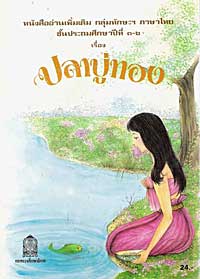 |
1. Fairy Tales. Prominent
characteristics of fairy tales include length of the story in
which there are several conflicting situations or sub-sections.
Main content of the story usually involves supernatural power or
miracles, which are uncommon to human way of life. Normally, it
does not clearly indicate the location in the story. Besides,
the main character possesses extraordinary attributes such as
charisma or magic that would finally overcome the obstacles and
conquer all of the enemies, with happy ending. Examples of Thai
fairy tales are Sanonoy Ruan Ngam, Pla Boo Thong, Nag Sib Song,
and Sung Thong, etc. (Kularb Mallikamas,1975, p. 106). This type
of folk tale has exciting story proceeding within an imaginary
world that contains wonders from supernatural power and miracles
of non-human charaters such as giants, angels, or the King of
Nagas. As such, this kind of tale is sometimes know as “Tales of
Wonders”. With their entertaining stories, the content of many
fairy tales have been modified into various performances such as
movies, dramas, Li Kay (Thai traditional dramatic performance),
and also other performances. |
|
Pla-boo-thong
(Picture from http://www.bangkokbookclub.com/shop/b/bangkokbookclub/img-lib/spd_20050411223730_b.jpg)
|
2. Legend.
In this type of folk tale, the story tellers strongly believes that the
incidents or the phenomena in such story do actually occur since there
are factual evidences, persons, and locations indicated in the legend
clearer than those mentioned in the myth. For example, Thai legends
include Phra Ruang, Chao Mae Soi Dok Mak, Tao Saen Pom, Muang Lab Lae,
Phra Ya Kong, and Phra Ya Phan, etc.
3. Explanatory Tale. This is the
kind of story that answers the question of “why” explaining the history
and origin of human beings, animals, and natural phenomena. Explanatory
tale explains names of locations, rationale of some beliefs, and stories
involved with the hidden treasure. Examples of Thai explanatory tales
are “why the crows are black”, “why the wasps have necked waist”, “why
the vinegar is forbidden in the town of Lop Buri”, and “Pu Som Fao Sap”.
Many tales are involved with locations such as “Koh Nu Koh Maew” in Song
Kla province, “Tham Pa Nag Koy” in Prae province, and “Khao Ta Mong Lai”
in Prachuab Kirikhan province

Koh Noo, Koh Maew
(Picture
from http://www.photohobby.net/webboard/post_photo/647a8.jpg)
|
4. Novella or romantic tales.
This type of tale has a long story comprising many sub-episodes
(Kingkaew Attakorn, 1976, p.15). Its content is more realistic.
Characters in the story are rather common people, because of
their ordinary lifestyles, than those in regality. Core content
of the story is related to affection, exasperation, infatuation,
fear, and adventures. Romantic tales are more sentimental than
myths. Main characters have to show their wisdom and skills in
solving problems and get through troubles with bravery and
patience for successfully conquering their obstacles and
enemies. Scenes and surrounding environments are also more
realistic. Well know Thai romantic tales are Khun Chang Khun
Paen, Phra Lor, and Krai Thong. Meanwhile, example of western
romantic tales is the Decameron Series while example oriental
romantic tale is the Arabian Night. |
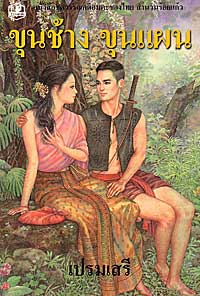 |
|
Khun Chang Khun
Paen (Picture from http://www.dokya.co.uk/images/big/B00856.jpg) |
5. Ghost tales.
Characters in ghost tales are inevitably ghosts and spiritual
divines. There are situations of ghost haunting and possessing. The
story is thrilling and frightening. Both story tellers and audiences
quite believe that ghost tales are true stories. Ghost tales clearly
reflects Thai people’s beliefs in ghosts and spiritual divines.
Appearances of ghosts or spiritual divines in the story are normally to
help human, to revenge, or to show their supernatural power.
6. Hero Tales. This type or tale
usually tells about moral, ability, acuity, and bravery of persons who
are the country’s heroes. Hero tales are similar to myths, whose main
characters are also heroes in the story. However, there are some
differences. That are, hero tales clearer indicate locations and times
in the story. Core content of hero tales mainly tell bravery and heroism
of heroes who fight for majority of people. Heroes are more adventurous
and braver than ordinary people. Example of western hero tales is
Robinhood while Thai hero tales are, for instance, Krai Thong, Chao Sai
Nam Pueng, Pra Ruang Wajasit. These hero tales include in the story the
names of persons, countries, situations, or story plots that are based
on true story and then modified for tale-telling purposes.

Hercules
(Picture from http://en.wikipedia.org/wiki/Hercules)
|
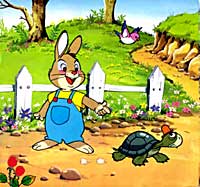 |
7. Fables. These are short
and unrealistic stories. However, fables contain moral lessons
that teach appropriate ways of living. Some fables give direct
lessons but others indirectly provide thoughts in a comparative
model. As such, fables are sometimes called the “object lessons”
or the “parables”. Characters running the story may be human,
animals, or angels. The stories are assumed to be happened in
the past such as the “Nu Kad Lek (a mouse bites steel)”, the
Isop’s tales, and the tales from Panja Tantra, etc. |
|
Isop's tales (Picture
from http://www.igetweb.com/www/iteen/private_folder/tour/esob1.jpg) |
8. Religious Tales.
These tales are related to religions, gods, priests, and also historic
miracles or supernatural power. There are many of these tales in the
west such as the stories of Jesus Christ and Saints. There are also some
Thai religious tales that involve supernatural power of priests who
possess high level of absorption and special supernatural power.
Examples of Thai religious tales are the story of “Luang Phor Tuad” and
“Somdej Chao Taeng Mo, etc.
|
9. Jataka Tales. According
to the Royal Institute Dictionary B.E.2546 (2003, p.359),
“Jataka” means the stories of Lord Buddha’s incarnations. In
each of those incarnations, the stories tell the Lord Buddha’s
hagiography and holy activities when the Lord Buddha
reincarnated as either human or a variety of animals. Despite
the different forms of lives in reincarnations, two distinct and
prominent characteristics of the Lord Buddha are always
observed. These characteristics are the Lord Buddha’s virtue and
his physical perfection. The Lord Buddha always incarnated in
masculinity with perfect body and voice. Such physical
appearance completely attracts the others seeing him. Regarding
the virtue characteristic, the Lord Buddha always reincarnated
with high moral principle and merits especially the “ten virtues”
(Pisit Charoensuk, 1996, pp.3-4), which include giving, scruple,
leaving from homes, intellectuality, diligence, patience,
faithfulness, blessing, mercy, and detachment. In Jataka tales,
morale and teachings of the Lord Buddha are blended into the
stories. At the end of the story, Jataka tales always tell
readers about reincarnations of main characters in that story.
One of the well known Jataka tales is “Tossa (ten) Jataka”,
particular the last episode Jataka called “Pra Wes San Don”. |
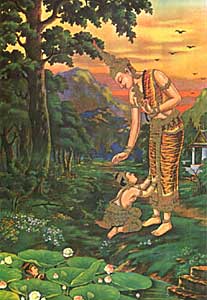 |
|
Pra Wes San Don (Picture
from http://www.thaigoodview.com/library/teachershow/poonsak/mahachat/chadok_08.html) |
10. Myths.
These are tales of which main characters are fairies or angels.
Otherwise, the characters in the story must be related to religion
beliefs and observances that are commonly practiced. Examples of myths
are ‘Tao Maha Song Kran” and those related to the God Indra.
11. Animal tale. In this kind of
tales, the main characters are animal, presumed to have human thoughts
and behaviors. These characters can be either wild animals or home pets.
In some stories, the characters may be human who can interact with
animals as if they are also human. Some stories shows cleverness or
foolishness of the animals. Sometimes, it can be a story of a cheating
animal that usually bully other animals and finally get into the
troubles. The animal tales are clearly told with the purpose to teach
about morale. Hence, the animal tale can also be classified as fables.
|
 |
12. Jests. Most of jests are
short tales. In this kind of story, its climax is the behavior
or situation that seems impossible. Jest tale may be a story of
foolishness, cleverness, or sharp thinking needed for
retaliation, gambling or adventures in a comic manner. Main
character of the story may be the most foolish person who has
the strangest behavior. Examples are the stories of “Sri
Thanonchai” and “Hua Laan Nok Krue”, etc.
Besides, there are jests that involve sexuality in an immodest
way so that they are told only in specific groups or on some
occasions. However, it can be noticed that this kind of Thai
tale strategically use linguistic techniques. That is, words are
played around by the spoonerism manner in order to make the
story amusing. If any listener cannot understand spoonerism, he/she
will be like a droll in their group at that moment. Thai jests
normally set the main characters as monks or nuns, whom usually
have to behavior well in brahmacharya (celibate and chaste) but
had behaved against the rules or committed improper sexual
behaviors such as, for example, the affairs between brother-in-law
and sister-in-law or the affairs between the son-in-law and
mother-in-law.
|
|
Sri Thanonchai (Picture
from http://shopping.sanook.com/buy/buy_detail.php?nitemID=996986) |
13. Formula tale.
This type of tale has its special way to tell stories in the different
format from other kind of tales. For example, it is told repeatedly and
continuously or there are many characters whose behaviors are
sequentially related. There are four categories of formula tale:
13.1 The endless tale. This tale has no limit length. It is
continuously told until the listeners become bored. This kind of tale
usually involves counting or repeated actions. It is suitable to
children’s interests.
13.2 The unfinished tale. The tellers use this kind of tale to
tease listeners in order to make them fun. The story starts from local
interesting story then immediately end without any sign or good reason.
13.3 Cheating tale. The story tellers intend to disguise
listeners by attracting them to be part of the story such as asking and
answering questions. When the listeners expect that their answer is
right, the tellers give another answer which is totally funny and
nonsense.
13.4 Chain Tale. This kind of tale is a non-stop story. There can
be many characters with sequential behaviors that may probably not be
related to the behavior of previous characters. A well known Thai chain
tale is “Yai Ka Ta Pluke Tua Pluke Nga Hai Larn Fao (the grand parent
growing bean and sesame plants then ask their grandchild to take care of
those plants).
14. Riddle tale. This type of tale
is told in the way that phrases are tied up to leave some challenging
clues within middle, the end or important part of the story in order to
allow participation from listeners or readers to express their opinions
or knowledge about that story. Riddle tales that are most found in
Thailand are Dharma Riddle tale, Vetala tale, and the well-known story
of “Song Kran”.
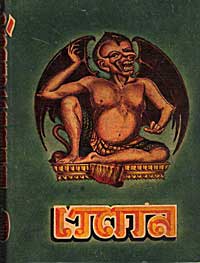
Vetala (Picture
from http://www.thainame.net/project/704/two.html)
The aforementioned category of tales is only a general way of
classification, not the inflexible one. Some types of tales may have
overlapped content. Readers should carefully consider the purposes and
attitudes of the tellers together with characteristics and contents of
tales before classifying them into appropriate category according to
their most prominent characteristics.
|
